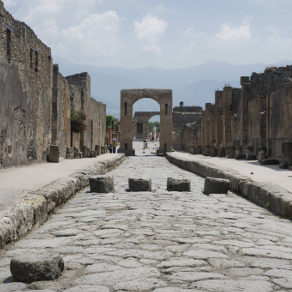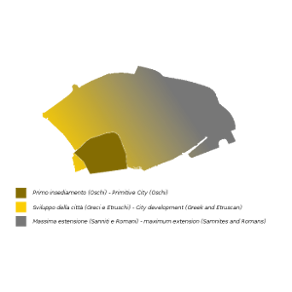Art and Techniques
The architectural styles used for Pompeian furniture are classic, due to the characteristic column capitals: Doric order (circular and without decorations); Ionic order (with decorations and volutes); Corinthian order (decorated with acanthus leaves); Composite order (a mix of Corinthian and ionic orders).
The structure changes in the ages, underling the period when each building was assembled or expanded.
During the Samnite period, firstly (IV-III centuries B.C.) the work was squared and undefined, then (200-80 B.C.) the building began to be made of tuff blocks.
During the Roman period (80 B.C.-14 A.D.) the building were made of irregular stones and small squared blocks that formed a diagonal pattern. Finally, in the last Roman period (14-79 A.D.) buildings made of brick were introduced.
In 1882, August Mau, a German scholar, attempted in a treatise to distinguish the decorations in four different styles corresponding to four periods.
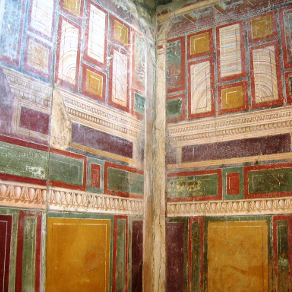
The first style, is also called the structural and incrustation style and it is the oldest; it spread out during the Samnite period (150-80 B.C.); it is characterized by the simulation of panels of various types of colored marble (known as incrustations) obtained with preparatory layer of stucco (House of Sallustio atrium, House of Faun exedra, the Basilica and the Temple of Jupiter). It had Hellenistic origins and for this reason there are many samples in the Greek cities.
The wall was divided in three parts: the first was decorated with yellow marbles; the central part was decorated with stone squared blocks that are painted with bright colors (red, black, purple, yellow and green to simulate marble, alabaster, porphyry and granite); the higher part was decorated with white stucco cornice.
Sometimes paintings could have some architectural elements such as columns or pilaster strips to define surface.
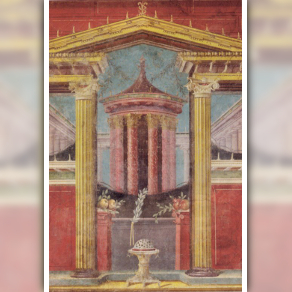
The second style, is also known as architectural style (popular between 80 B.C. and 14 A.D.) and it was characterized by the architectural features and trompe d’oeil (a French definition that could be translated as "trick of the eye") compositions.
Typically this architectural trompe l’oeil included porticos, aedicule, doors, windows and colonnades that pass off as three-dimensional realities: so they gave the illusion of real objects that are painted on a two-dimensional surface and the felling of a more extended space.
There are two variations of this style, explained by Vitruvius, a Roman architect, in a book where he described the "ancient" painting: the landscapes pictures represented faithfully gardens, ports, coasts, rivers, mountains, woods, buildings; the megalographia was figurative series with figures that are the same size as viewers, inspired by the Hellenic picture (see the House of Obellius Firmus, the House of the Labyrinth, the House of the Silver Wedding, the House of the Cryptoporticus, the Dionysiac mystery frieze in the Villa of the Mysteries).
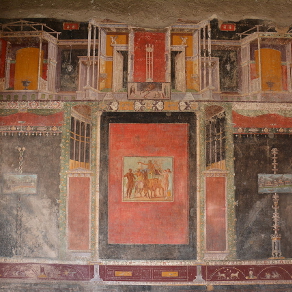
The third style, known as the ornate style, was born under the August’s empire (14-62 A.D.) and it is characterized by a minor figurative abundance.
The typical wall is characterized by a series of monochromatic panels (black, red, white, yellow and rarely blue) that in the middle had small squares (that are called with the Greek term "pinakes") or medals with panoramic view, mythological scenes, human faces, or still life. The monochromatic panels and the higher part of the walls were decorated with strips, candelabra, wreaths, carpet edge or small isolated figures such as nymphs, satyrs and loveseats (see the House of Lucretius Fronto, the tablinium in the House of Caecilius Jucundus or the triclinium of Amandus).
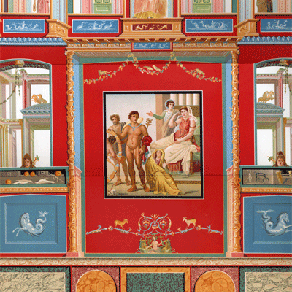
The fourth style, called the fantastic style dates back to the Nero period (62-79 A.D.) and it was spectacular because it used and mixed the typical elements of the Second and Third Styles.
The wall was divided vertically:
the base, decorated like the marble coverings or with plant motifs or decorative medals;
the central part there were the big monochromatic panels, typical in the third style, but they incorporated central panel pictures (with mythological theme); the central panel had he architectural details of the Second Style revived in a fantastic way (they were unreal, with recess and aedicule supported by weak pedestals, sometimes composed by candelabra or stalks);
the higher part had architectonical representations or panoramic views. Once again wreaths, strips, carpet edges and small isolated figures (sat on the cornice of the fantastic architecture, boarding the painted doors or even isolated in the middle of side panels) completed and enriched further the totality (see the triclinium in the House of the Vettii, the House of the Lovers, the House of the Menander, the House of Loreius Tiburtinus).
It is interesting to know that, according to some researches, in the ancient city of Pompeii, the houses and the public buildings decorated with the famous "Pompeian red" were not so many as ones whose walls are now perceived as red: in the latter the characteristic red color was actually an ochre yellow (a pigment obtained with the production of the dirt that was easily reachable and cheap) that was modified by the high temperature gas that preceded the Vesuvius eruption in 79 A.D.. This effect can be perceived by eye in the cracks of the red wall of Pompeii and Herculaneum and it was already known by the Ancients: indeed Pliny explained that from ochre yellow you can get the red tone making it in the oven.
Originally the red colour was obtained from the waste of cinnabar production, a mineral from which mercury is extracted but it was used with moderation due to the high cost of manufacturing. During the Roman age it began to be used especially to paint the walls of the sumptuous house of the rich owners.
Since the cinnabar contains considerable quantity of mercury that is highly toxic for human health, the colour was gradually replaced by red ochre, an inorganic natural pigment that derived from natural hematite (the mineral form of iron).


